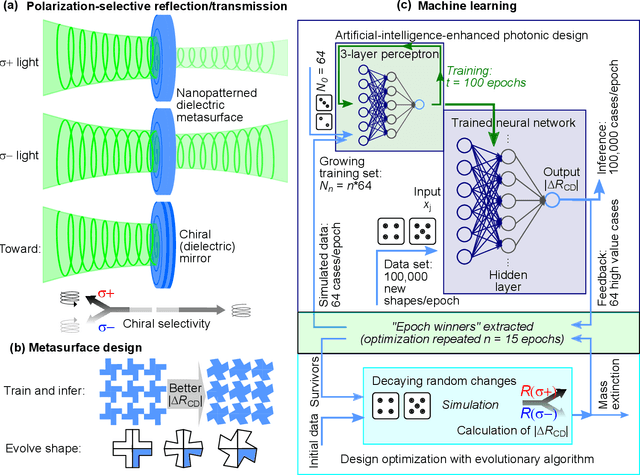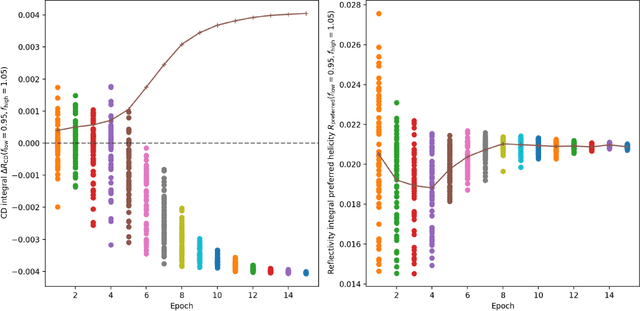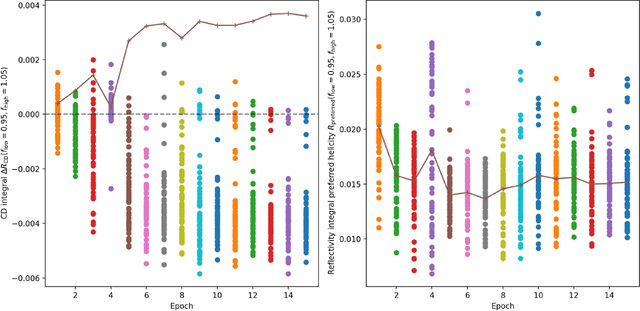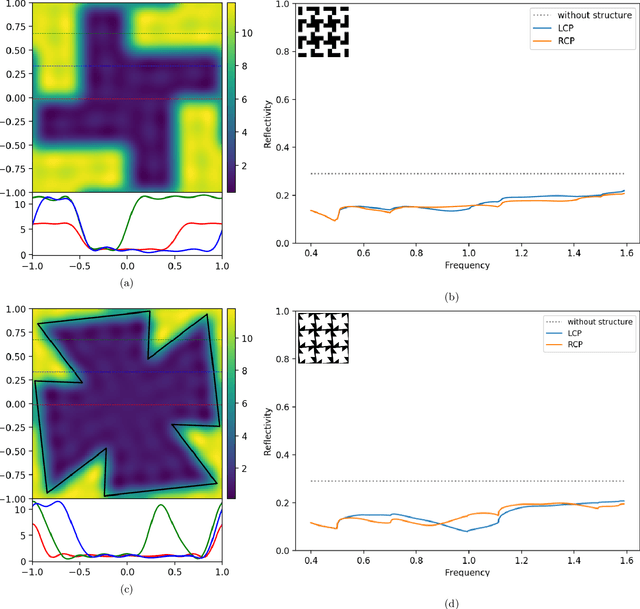Arash Rahimi-Iman
Advancing Machine Learning Optimization of Chiral Photonic Metasurface: Comparative Study of Neural Network and Genetic Algorithm Approaches
Dec 15, 2025Abstract:Chiral photonic metasurfaces provide unique capabilities for tailoring light-matter interactions, which are essential for next-generation photonic devices. Here, we report an advanced optimization framework that combines deep learning and evolutionary algorithms to significantly improve both the design and performance of chiral photonic nanostructures. Building on previous work utilizing a three-layer perceptron reinforced learning and stochastic evolutionary algorithm with decaying changes and mass extinction for chiral photonic optimization, our study introduces a refined pipeline featuring a two-output neural network architecture to reduce the trade-off between high chiral dichroism (CD) and reflectivity. Additionally, we use an improved fitness function, and efficient data augmentation techniques. A comparative analysis between a neural network (NN)-based approach and a genetic algorithm (GA) is presented for structures of different interface pattern depth, material combinations, and geometric complexity. We demonstrate a twice higher CD and the impact of both the corner number and the refractive index contrast at the example of a GaP/air and PMMA/air metasurface as a result of superior optimization performance. Additionally, a substantial increase in the number of structures explored within limited computational resources is highlighted, with tailored spectral reflectivity suggested by our electromagnetic simulations, paving the way for chiral mirrors applicable to polarization-selective light-matter interaction studies.
Towards Neural-Network-based optical temperature sensing of Semiconductor Membrane External Cavity Laser
Oct 29, 2024



Abstract:A machine-learning non-contact method to determine the temperature of a laser gain medium via its laser emission with a trained few-layer neural net model is presented. The training of the feed-forward Neural Network (NN) enables the prediction of the device's properties solely from spectral data, here recorded by visible-/nearinfrared-light compact micro-spectrometers for both a diode pump laser and optically-pumped gain membrane of a semiconductor disk laser. Fiber spectrometers are used for the acquisition of large quantities of labelled intensity data, which can afterwards be used for the prediction process. Such pretrained deep NNs enable a fast, reliable and easy way to infer the temperature of a laser system such as our Membrane External Cavity Laser, at a later monitoring stage without the need of additional optical diagnostics or read-out temperature sensors. With the miniature mobile spectrometer and the remote detection ability, the temperature inference capability can be adapted for various laser diodes using transfer learning methods with pretrained models. Here, mean-square-error values for the temperature inference corresponding to sub-percent accuracy of our sensor scheme are reached, while computational cost can be saved by reducing the network depth at the here displayed cost of accuracy, as appropriate for different application scenarios.
Machine Learning-Based Optimization of Chiral Photonic Nanostructures: Evolution- and Neural Network-Based Design
Nov 11, 2021



Abstract:Chiral photonics opens new pathways to manipulate light-matter interactions and tailor the optical response of meta-surfaces and -materials by nanostructuring nontrivial patterns. Chirality of matter, such as that of molecules, and light, which in the simplest case is given by the handedness of circular polarization, have attracted much attention for applications in chemistry, nanophotonics and optical information processing. We report the design of chiral photonic structures using two machine learning methods, the evolutionary algorithm and neural network approach, for rapid and efficient optimization of optical properties for dielectric metasurfaces. The design recipes obtained for visible light in the range of transition-metal dichalcogenide exciton resonances show a frequency-dependent modification in the reflected light's degree of circular polarization, that is represented by the difference between left- and right-circularly polarized intensity. Our results suggest the facile fabrication and characterization of optical nanopatterned reflectors for chirality-sensitive light-matter coupling scenarios employing tungsten disulfide as possible active material with features such as valley Hall effect and optical valley coherence.
 Add to Chrome
Add to Chrome Add to Firefox
Add to Firefox Add to Edge
Add to Edge